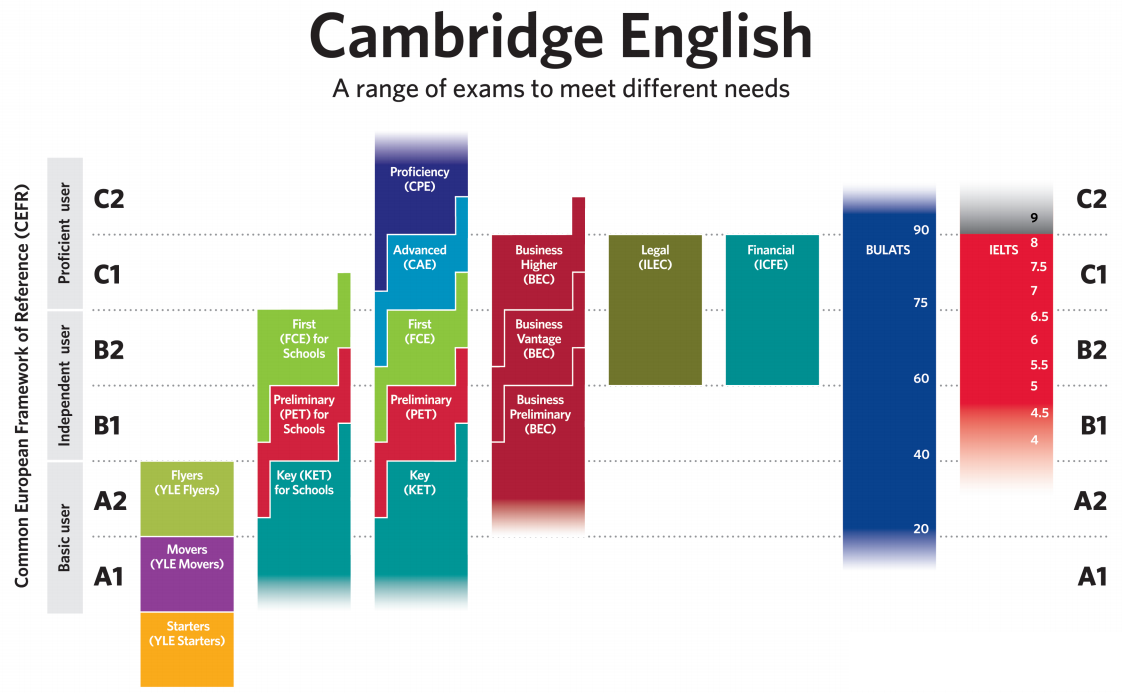

The Common European Framework of Reference for Languages (CEFR) plays a central role in language and education policy worldwide. It has growing relevance for language testers and examination boards, helping to define language proficiency levels and interpret language qualifications.
The CEFR describes language ability on a scale of levels from A1 for beginners up to C2 for those who have mastered a language. This makes it easy for anyone involved in language teaching and testing (learners, teachers, teacher trainers, etc.) to see the level of different qualifications. It also means that employers and educational institutions can easily compare qualifications and see how they relate to exams they already know in their own country.

See a larger version of the CEFR diagram here
| Council of Europe levels | Description |
C2Mastery | The capacity to deal with material which is academic or cognitively demanding, and to use language to good effect at a level of performance which may in certain respects be more advanced than that of an average native speaker. |
C1Effective Operational Proficiency | The ability to communicate with the emphasis on how well it is done, in terms of appropriacy, sensitivity and the capacity to deal with unfamiliar topics. |
B2Vantage | The capacity to achieve most goals and express oneself on a range of topics. |
B1Threshold | The ability to express oneself in a limited way in familiar situations and to deal in a general way with nonroutine information. |
A2Waystage | An ability to deal with simple, straightforward information and begin to express oneself in familiar contexts. |
A1Breakthrough | A basic ability to communicate and exchange information in a simple way. |
| A2 | B1 |
Cambridge English Key (KET) PTE General Level 1 PTE Academic 30-42 | Cambridge English Preliminary (PET) BEC Prelim IELTS 4-4.5 TOEFL iBT 57-86 TOEIC 550 PTE General Level 2 PTE Academic 43-58 Trinity ISE I |
| B2 | C1 |
Cambridge English First (FCE) BEC Vantage IELTS 5-6.5 TOEFL iBT 87-109 Michigan ECCE PTE General Level 3 PTE Academic 59-75 Trinity ISE II | Cambridge English Advanced (CAE) BEC Higher IELTS 7-8 TOEFL iBT 110-120 TOEIC 880 PTE General Level 4 PTE Academic 76-84 |
| C2 |
Cambridge English Proficiency (CPE) IELTS 8.5-9 Michigan ECPE PTE General Level 5 PTE Academic 85+ |
Grammar to study at each CEF level
| A1 | A2 |
| Adjectives: common and demonstrative Adverbs of frequency Comparatives and superlatives Going to How much/how many and very common uncountable nouns I’d like Imperatives (+/-) Intensifiers - very basic Modals: can/can’t/could/couldn’t Past simple of “to be” Past Simple Possessive adjectives Possessive s Prepositions, common Prepositions of place Prepositions of time, including in/on/at Present continuous Present simple Pronouns: simple, personal Questions There is/are To be, including question+negatives Verb + ing: like/hate/love | Adjectives – comparative, – use of than and definite article Adjectives – superlative – use of definite article Adverbial phrases of time, place and frequency – including word order Adverbs of frequency Articles – with countable and uncountable nouns Countables and Uncountables: much/many Future Time (will and going to) Gerunds Going to Imperatives Modals – can/could Modals – have to Modals – should Past continuous Past simple Phrasal verbs – common Possessives – use of ‘s, s’ Prepositional phrases (place, time and movement) Prepositions of time: on/in/at Present continuous Present continuous for future Present perfect Questions Verb + ing/infinitive: like/want-would like Wh-questions in past Zero and 1st conditional |
| B1 | B2 |
| Adverbs Broader range of intensifiers such as too, enough Comparatives and superlatives Complex question tags Conditionals, 2nd and 3rd Connecting words expressing cause and effect, contrast etc. Future continuous Modals - must/can’t deduction Modals – might, may, will, probably Modals – should have/might have/etc Modals: must/have to Past continuous Past perfect Past simple Past tense responses Phrasal verbs, extended Present perfect continuous Present perfect/past simple Reported speech (range of tenses) Simple passive Wh- questions in the past Will and going to, for prediction | Adjectives and adverbs Future continuous Future perfect Future perfect continuous Mixed conditionals Modals – can’t have, needn’t have Modals of deduction and speculation Narrative tenses Passives Past perfect Past perfect continuous Phrasal verbs, extended Relative clauses Reported speech Will and going to, for prediction Wish Would expressing habits, in the past |
| C1 |
| Futures (revision) Inversion with negative adverbials Mixed conditionals in past, present and future Modals in the past Narrative tenses for experience, incl. passive Passive forms, all Phrasal verbs, especially splitting Wish/if only regrets |

That´s all folks! :)
Join the Docenteca Community and share your info, material and resources!